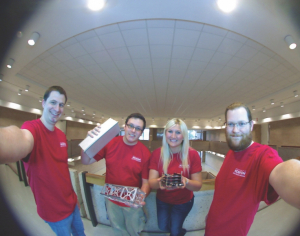A year’s worth of hard work paid off for a team of electrical and computer engineering students in the UH Cullen College of Engineering when their small satellite technology was launched into space this month.
Small satellites, also known as CubeSats, are 10-centimeter sized cubical satellites that occupy low Earth orbit, collecting invaluable data for a wide range of scientific applications. On Jan. 29, 2016 at 10:25 a.m., astronaut Scott Kelly deployed CubeSats that contained software designed by the UH engineering students from the Japanese Experiment Module (JEM), a Japanese science module on the International Space Station (ISS).
The UH student team invented their novel technology as part of their senior design project, spearheaded by ECE professor Steve Provence, a NASA engineer and alumnus of the Cullen College’s ECE department. For this project, the UH team worked closely with researchers at the University of Texas at Austin, Texas A&M University and Georgia Tech University.
“We really depended on them to get this work done and find a solution,” said Provence. “From experiencing this process, the students have a better understanding of what it means to be a real world engineer, and to have an assignment they don’t already know has a solution.”
The ECE students involved in this project took on the challenge after a 2009 CubeSat mission led by teams at Texas A&M University and the University of Texas was unsuccessful without definitive answers. While the satellite was being deployed from the payload bay of space shuttle Endeavour, CubeSats Bevo-1 and AggieSat2 were to separate. They never did, and with little evidence of what caused the failure, the students were left without explanation.
Working closely with both NASA and AggieSat students, the ECE team designed and built a visual data capture system (VDCS) to photograph the ejection of the CubeSat, called AggieSat4, into low Earth orbit from a full-size satellite.
With a fish-eye lens that captures almost 180 degrees, the camera in the VDCS should have captured images in the seconds before deployment and recorded any conditions affecting the bay door. As Bevo-2, the University of Texas’ CubeSat for this project, detached from AggieSat4, the camera will take 10 rapid-fire sequences in about 10 seconds. The VDCS will have several other photographic missions once the satellite is launched from the bay of the ISS.
“This project provided confidence in myself as an engineer,” said Emery Annis, team member of the UH senior design project. “I learned that I can take on any task, regardless of my skill level, identify the project restraints and requirements, and collaborate with a group of engineers to ultimately deliver a successful product on time and under budget.”
View a video of the launch here.
